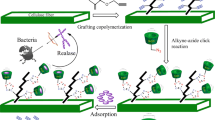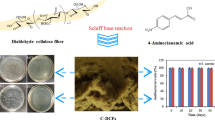Abstract
Development of advanced functional materials from naturally abundant polymers such as cellulose are of significant importance. Of particular interest is embedding antibacterial functionality to cellulose materials to make permanent antibacterial materials and devices. In the present research, a “clickable” quaternary ammonium compound, N-(2-ethoxy-2-oxoethyl)-N,N-dimethylprop-2yn-1-aminium bromide (EdMPABr) was synthesized via a simple reaction with nearly stoichiometric yield and well characterized with 1D (1H, 13C) and 2D (COSY, HSQC) NMR and ATR-FTIR. EdMPABr can be covalently bonded to many molecules containing an azido group to form non-leaching antibacterial materials via the simple Cu(I)-catalyzed alkyne-azide [2 + 3] cycloaddition reaction. As an example, EdMPABr was attached to our previously reported 3-O-azidopropoxypoly(ethylene glycol)-2,6-di-O-thexyldimethylsilyl cellulose (3-N3PEG-2,6-TDMS cellulose, DS = 0.54 at C3 determined by 1H NMR). Significant antibacterial activity of the synthesized 3-O-quaternary ammonium-2,6-di-O-thexyldimethylsilyl cellulose (3-QA-2,6-TDMS cellulose, DS = 0.30 at C3 determined by using N content from elemental analysis) was confirmed by testing against the representative bacteria Escherichia coli. By linking the EdMPABr to the honeycomb film of 3-N3PEG-2,6-TDMS cellulose, the formed honeycomb film exhibited both antibacterial and antifouling properties. This research provides a simple and robust route towards the development of permanent antibacterial materials and biomedical devices.










Similar content being viewed by others
References
Andresen M, Stenstad P, Moretro T, Langsrud S, Syverud K, Johansson L-S, Stenius P (2007) Nonleaching antimicrobial films prepared from surface-modified microfibrillated cellulose. Biomacromolecules 8(7):2149–2155
Bar-Nir BB-A, Kadla JF (2009) Synthesis and structural characterization of 3-O-ethylene glycol functionalized cellulose derivatives. Carbohydr Polym 76:60–67
Biswas A, Shogren RL, Willett JL (2005) Solvent-free process to esterify polysaccharides. Biomacromolecules 6(4):1843–1845
Bock VD, Hiemstra H, van Maarseveen JH (2006) Cu-I-catalyzed alkyne-azide “click” cycloadditions from a mechanistic and synthetic perspective. Eur J Org Chem 1:51–68
Brayner R, Ferrari-Iliou R, Brivois N, Djediat S, Benedetti MF, Fievet F (2006) Toxicological impact studies based on Escherichia Coli bacteria in ultrafine ZnO nanoparticles colloidal medium. Nano Lett 6(4):866–870
Cheng G, Xue H, Zhang Z, Chen S, Jiang S (2008) A switchable biocompatible polymer surface with self-sterilizing and nonfouling capabilities. Angew Chem Int Ed Engl 47(46):8831–8834
Dizman B, Elasri MO, Mathias LJ (2006) Synthesis and antibacterial activities of water-soluble methacrylate polymers containing quaternary ammonium compounds. J Polym Sci A1 44(20):5965–5973
Fenn D, Pfeifer A, Heinze T (2007) Studies on the synthesis of 2,6-di-O-thexyldimethyl silyl cellulose. Cellul Chem Technol 41(2–3):87–91
Fokin VV, Rostovtsev VV, Green LG, Sharpless KB (2002) A stepwise Huisgen cycloaddition process: copper(I)-catalyzed regioselective “ligation” of azides and terminal alkynes. Angew Chem Int Ed 41(14):2596
Fu G, Vary PS, Lin C-T (2005) Anatase TiO2 nanocomposites for antimicrobial coatings. J Phys Chem B 109(18):8889–8898
Hou A, Zhou M, Wang X (2009) Preparation and characterization of durable antibacterial cellulose biomaterials modified with triazine derivatives. Carbohydr Polym 75(2):328–332
Jampala SN, Sarmadi M, Somers EB, Wong ACL, Denes FS (2008) Plasma-enhanced synthesis of bactericidal quaternary ammonium thin layers on stainless steel and cellulose surfaces. Langmuir 24(16):8583–8591
Jawaid M, Abdul Khalil HPS (2011) Cellulosic/synthetic fibre reinforced polymer hybrid composites: a review. Carbohydr Polym 86(1):1–18
Kang S, Pinault M, Pfefferle LD, Elimelech M (2007) Single-walled carbon nanotubes exhibit strong antimicrobial activity. Langmuir 23(17):8670–8673
Klemm D, Kramer F, Moritz S, Lindström T, Ankerfors M, Gray D, Dorris A (2011) Nanocelluloses: a new family of nature-based materials. Angew Chem Int Ed 50(24):5438–5466
Klibanov AM (2007) Permanently microbicidal materials coatings. J Mater Chem 17(24):2479–2482
Koschella A, Klemm D (1997) Silylation of cellulose regiocontrolled by bulky reagents and dispersity in the reaction media. Macromol Symp 120(1):115–125
Koschella A, Heinze T, Klemm D (2001) First synthesis of 3-O-functionalized cellulose ethers via 2,6-di-O-protected silyl cellulose. Macromol Biosci 1(1):49–54
Lee Y-L, Cesario T, Wang Y, Shanbrom E, Thrupp L (2003) Antibacterial activity of vegetables and juices. Nutrition 19(11–12):994–996
McDonnell G, Russell AD (1999) Antiseptics and disinfectants: activity, action, and resistance. Clin Microbiol Rev 12(1):147–179
Neal A (2008) What can be inferred from bacterium–nanoparticle interactions about the potential consequences of environmental exposure to nanoparticles? Ecotoxicology 17(5):362–371
Roy D, Knapp JS, Guthrie JT, Perrier S (2008) Antibacterial cellulose fiber via raft surface graft polymerization. Biomacromolecules 9(1):91–99
Shateri Khalil-Abad M, Yazdanshenas M, Nateghi M (2009) Effect of cationization on adsorption of silver nanoparticles on cotton surfaces and its antibacterial activity. Cellulose 16(6):1147–1157
Stoimenov PK, Klinger RL, Marchin GL, Klabunde KJ (2002) Metal oxide nanoparticles as bactericidal agents. Langmuir 18(17):6679–6686
Sureshkumar M, Siswanto DY, Lee C-K (2010) Magnetic antimicrobial nanocomposite based on bacterial cellulose and silver nanoparticles. J Mater Chem 20(33):6948–6955
Thorsteinsson T, Masson M, Kristinsson KG, Hjalmarsdottir MA, Hilmarsson H, Loftsson T (2003) Soft antimicrobial agents: synthesis and activity of labile environmentally friendly long chain quaternary ammonium compounds. J Med Chem 46(19):4173–4181
von Nussbaum F, Brands M, Hinzen B, Weigand S, Häbich D (2006) Chemistry—exodus or revival? Angew Chem Int Ed 45(31):5072–5129
Wang H, Gurau G, Rogers RD (2012) Ionic liquid processing of cellulose. Chem Soc Rev 41(4):1519–1537
Widawski G, Rawiso M, Francois B (1994) Self-organized honeycomb morphology of star-polymer polystyrene films. Nature 369(6479):387–389
Xu WZ, Kadla JF (2013) Honeycomb films of cellulose azide: molecular structure and formation of porous films. Langmuir 29(2):727–733
Xu WZ, Zhang X, Kadla JF (2012) Design of functionalized cellulosic honeycomb films: site-specific biomolecule modification via “click chemistry”. Biomacromolecules 13(2):350–357
Yabu H, Takebayashi M, Tanaka M, Shimomura M (2005) Superhydrophobic and lipophobic properties of self-organized honeycomb and pincushion structures. Langmuir 21(8):3235–3237
Yoon K-Y, Hoon Byeon J, Park J-H, Hwang J (2007) Susceptibility constants of Escherichia coli and Bacillus subtilis to silver and copper nanoparticles. Sci Total Environ 373(2–3):572–575
Zugenmaier P (2009) Contribution to the historical development of macromolecular chemistry—exemplified on cellulose. Cellul Chem Technol 43(9–10):351–378
Acknowledgments
This work was financially supported by the SENTINEL bioactive paper network. Special thanks go to Mr. Kevin Hodgson, light microscopy technician at UBC bioimaging facility, for assistance in the confocal microscopy measurements, Mr. Derrick Horne, senior electron microscopy technician at UBC bioimaging facility, for assistance in the EDX elemental analysis, and Mr. Reza Korehei for assistance in the test of antibacterial activity.
Author information
Authors and Affiliations
Corresponding author
Rights and permissions
About this article
Cite this article
Xu, W.Z., Gao, G. & Kadla, J.F. Synthesis of antibacterial cellulose materials using a “clickable” quaternary ammonium compound. Cellulose 20, 1187–1199 (2013). https://doi.org/10.1007/s10570-013-9914-6
Received:
Accepted:
Published:
Issue Date:
DOI: https://doi.org/10.1007/s10570-013-9914-6




